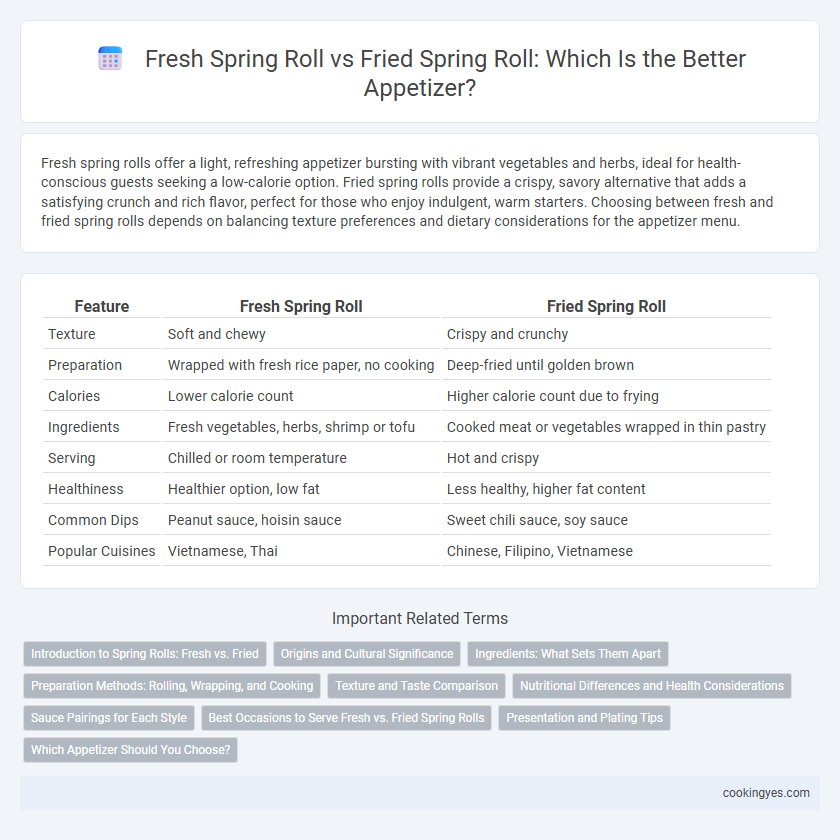Fresh spring rolls offer a light, refreshing appetizer bursting with vibrant vegetables and herbs, ideal for health-conscious guests seeking a low-calorie option. Fried spring rolls provide a crispy, savory alternative that adds a satisfying crunch and rich flavor, perfect for those who enjoy indulgent, warm starters. Choosing between fresh and fried spring rolls depends on balancing texture preferences and dietary considerations for the appetizer menu.
Table of Comparison
| Feature | Fresh Spring Roll | Fried Spring Roll |
|---|---|---|
| Texture | Soft and chewy | Crispy and crunchy |
| Preparation | Wrapped with fresh rice paper, no cooking | Deep-fried until golden brown |
| Calories | Lower calorie count | Higher calorie count due to frying |
| Ingredients | Fresh vegetables, herbs, shrimp or tofu | Cooked meat or vegetables wrapped in thin pastry |
| Serving | Chilled or room temperature | Hot and crispy |
| Healthiness | Healthier option, low fat | Less healthy, higher fat content |
| Common Dips | Peanut sauce, hoisin sauce | Sweet chili sauce, soy sauce |
| Popular Cuisines | Vietnamese, Thai | Chinese, Filipino, Vietnamese |
Introduction to Spring Rolls: Fresh vs. Fried
Fresh spring rolls offer a light, healthy appetizer option with transparent rice paper wrapping fresh vegetables, herbs, and lean proteins like shrimp or tofu. Fried spring rolls provide a crispy, savory contrast, featuring a golden, crunchy exterior that encases a flavorful mixture of meats, vegetables, and sometimes noodles. Both variations serve as popular starter dishes in Asian cuisine, appealing to different texture and flavor preferences.
Origins and Cultural Significance
Fresh spring rolls, also known as Vietnamese goi cuon, originate from Vietnam and emphasize fresh ingredients like shrimp, herbs, and rice paper, symbolizing health and balance in Vietnamese cuisine. Fried spring rolls, with roots in both Chinese and Southeast Asian culinary traditions, feature a crispy wrapper filled with savory meats and vegetables, representing celebration and warmth during festivals. Both appetizers hold cultural significance as iconic dishes showcasing regional flavors and culinary heritage.
Ingredients: What Sets Them Apart
Fresh spring rolls feature translucent rice paper wrapped around vibrant ingredients like shrimp, fresh herbs, vermicelli noodles, and crisp vegetables, highlighting their light and healthy profile. Fried spring rolls use a thicker wheat-based wrapper that crisps to golden perfection when deep-fried, typically filled with cooked meats, cabbage, carrots, and glass noodles, which create a savory and crunchy texture. The fundamental difference lies in the cooking method and wrapper type, influencing both the flavor and nutritional content of each appetizer.
Preparation Methods: Rolling, Wrapping, and Cooking
Fresh spring rolls feature delicate rice paper wrappers filled with crisp vegetables, herbs, and protein, rolled tightly without cooking to preserve freshness and texture. Fried spring rolls use a wheat-based wrapper that is wrapped more firmly around ingredients before deep-frying to achieve a golden, crispy exterior. The preparation method significantly impacts the final texture and flavor, with fresh rolls highlighting raw, vibrant ingredients and fried rolls offering a crunchy, savory bite.
Texture and Taste Comparison
Fresh spring rolls offer a crisp and refreshing texture with a bright, herbal taste from fresh vegetables and herbs, making them a lighter appetizer option. Fried spring rolls deliver a crunchy, golden-brown exterior with a warm, savory filling, providing a rich and satisfying flavor contrast. The choice between fresh and fried spring rolls hinges on preference for either a delicate, fresh taste or a bold, crispy texture.
Nutritional Differences and Health Considerations
Fresh spring rolls contain fewer calories and less fat compared to fried spring rolls, making them a healthier appetizer choice rich in fresh vegetables and lean protein. Fried spring rolls typically have higher sodium levels and increased saturated fat due to the deep-frying process, which can impact heart health negatively. Choosing fresh spring rolls supports better digestion and promotes nutrient retention, essential for a balanced diet.
Sauce Pairings for Each Style
Fresh spring rolls pair exceptionally well with light, tangy dipping sauces such as hoisin-peanut or nuoc cham, enhancing the natural flavors of fresh herbs and vegetables. Fried spring rolls benefit from richer, more robust sauces like sweet chili or plum sauce that complement their crispy, savory exterior. Choosing the right sauce elevates the appetizer experience by balancing texture and flavor for each spring roll style.
Best Occasions to Serve Fresh vs. Fried Spring Rolls
Fresh spring rolls suit warm-weather gatherings, light lunches, and health-conscious events due to their crisp vegetables and fresh herbs wrapped in rice paper. Fried spring rolls offer a crispy, savory option ideal for parties, game days, and festive celebrations where a rich, indulgent appetizer is desired. Choosing between fresh and fried spring rolls depends on the event's atmosphere, guest preferences, and desired flavor profiles.
Presentation and Plating Tips
Fresh spring rolls offer a vibrant presentation with translucent rice paper that showcases colorful vegetables and herbs, making them visually appealing on minimalist white plates garnished with edible flowers or fresh cilantro sprigs. Fried spring rolls present a golden-brown, crispy texture that contrasts well on dark or rustic serving platters, often accompanied by small dipping bowls of sweet chili or hoisin sauce to enhance the plating arrangement. Using angled stacking or fan layouts for either type elevates the appetizer's aesthetic, inviting diners to enjoy the dish both visually and gastronomically.
Which Appetizer Should You Choose?
Fresh spring rolls offer a lighter, healthier appetizer option rich in vegetables, herbs, and lean protein, making them ideal for those seeking a refreshing start to a meal. Fried spring rolls provide a crispy, savory experience with a golden-brown exterior, appealing to guests who prefer a warm, indulgent bite. Choose fresh spring rolls for a nutrient-dense, low-calorie choice or fried spring rolls for a satisfying, crunchy appetizer.
Fresh spring roll vs fried spring roll for appetizer Infographic

 cookingyes.com
cookingyes.com